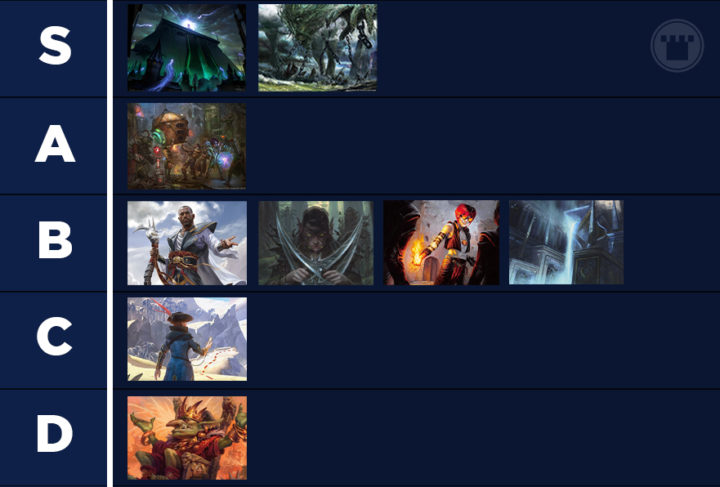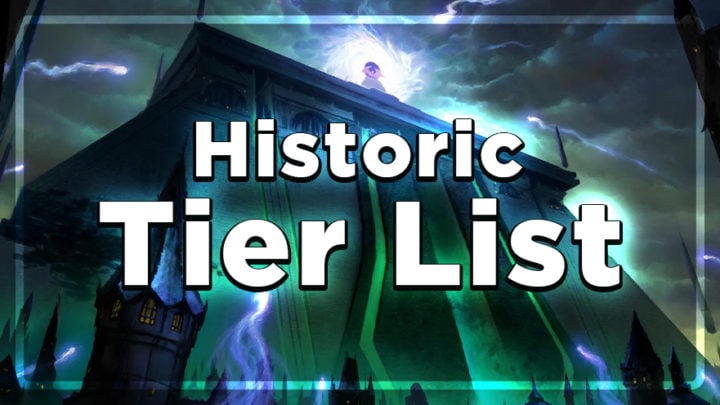Welcome to the Historic ladder tier list! Each week, we’ll cover a format and share a tier list of decks you can expect to see on the ladder. This tier list is focused heavily on the Arena ladder; some decks are capable of spiking some wins, but when talking about the ladder, we’re looking for consistency over a large sample of games.
Before we dive into the list, I want to lay out my grading criteria to help contextualize my recommendations:
S Tier: Decks that are above the rest. This is normally the default “best deck in the format” and the deck(s) you should have in mind when building or picking your deck.
A Tier: Decks that are great. These decks are knocking on the door of S Tier, but they may have a small weakness that keeps them out of the upper echelon.
B Tier: Good, solid decks. You wouldn’t be surprised if a B Tier deck takes down an event, but they have bigger weaknesses or liabilities than the decks in A Tier.
C Tier: Decks that are totally fine, but not notable. These decks aren’t exactly tearing up the tournament or ladder scene, but you should expect to face them every now and then.
D Tier: Decks with strong elements, but that generally aren’t great choices compared to the rest of the format.
Last week saw the banning of Field of the Dead, and the format is still settling down. Midrange and control decks have opened back up with Field leaving; these decks no longer need to focus on beating a single card just to have a chance. Most of the midrange decks have evolved into Uro decks and surprisingly, the same has happened for control. Aggressive decks are also happy to see Field gone, since they no longer have to contend with a flood of zombies on turn four.
The whole landscape has completely changed, and a new crop of decks have been racking up wins on the ladder. Let’s go through them one by one.


Citadel Combo

The first deck in S Tier is Citadel combo, which encompasses a few different builds. There’s an “all-in” Golgari build of the deck that can consistently turbo out Bolas’s Citadel on turn four. There are Abzan builds that focus on having a better sideboard and using Collected Company more effectively. But the build I’d consider the best right now is Jund.
Jund Citadel gets access to Mayhem Devil and Claim the Firstborn, which are both powerful removal spells in the format and also mirror breakers. This deck can out-grind every deck in the format and combo kill off the top of the deck. Jund uses Woe Strider to scry through your deck, and Blood Artist can mitigate the life you lose by casting spells with Citadel. It’s built to be the best Bolas’s Citadel deck possible, and it shows.
4 Blood Artist
4 Blood Crypt
4 Bolas’s Citadel
2 Claim the Firstborn
3 Collected Company
2 Dragonskull Summit
1 Forest
4 Gilded Goose
4 Llanowar Elves
4 Mayhem Devil
2 Midnight Reaper
4 Overgrown Tomb
2 Paradise Druid
2 Phyrexian Tower
4 Priest of Forgotten Gods
4 Stomping Ground
1 Swamp
1 Vraska, Golgari Queen
4 Woe Strider
4 Woodland Cemetery
Sideboard
1 Claim the Firstborn
1 Jegantha, the Wellspring
1 Kroxa, Titan of Death’s Hunger
3 Reclamation Sage
3 Scavenging Ooze
4 Thoughtseize
1 The Immortal Sun
1 Vraska, Golgari Queen
Citadel is a card I expect to see banned from the format sooner rather than later. Till that time comes, I think Citadel is probably a reasonable choice at worst.
Sultai Midrange

Sultai Midrange has become a big player in the past week. The deck looks very similar to its Standard counterpart, but with a few key upgrades — most notably answers like Thoughtseize and Pact of Negation. Thoughtseize is an obvious upgrade over Thought Erasure, but Pact of Negation is a bit of a standout. Traditionally, Pact is used in combo decks to win counterspell fights and protect your combo, but thanks to all the extra mana this Sultai deck can make, Pact fits in here as well. Now, you get to tap out to deploy game-ending threats like Uro or Nissa without leaving yourself vulnerable to your opponent’s haymakers.
The best thing about this deck is that you can take it in a lot of different directions and tune it to the metagame you expect. The version I’m sharing today is a bit more ramp-heavy, but I’ve played some builds that have more reactive cards and less ramp. I’m highlighting this build because I think it’s best to have a proactive game plan on the Arena ladder; you can always reconfigure the deck to be more controlling post-board.This is one of Sultai’s biggest strengths: it has a classic midrange game plan that you can adapt while also being able to close the door very quickly, thanks to Nissa and Uro.
4 Breeding Pool
2 Castle Vantress
4 Explore
2 Extinction Event
4 Fabled Passage
2 Forest
2 Growth Spiral
3 Heartless Act
2 Hinterland Harbor
2 Hydroid Krasis
2 Island
2 Maelstrom Pulse
2 Narset, Parter of Veils
3 Nissa, Who Shakes the World
4 Overgrown Tomb
3 Pact of Negation
1 Swamp
4 Thoughtseize
4 Uro, Titan of Nature’s Wrath
3 Watery Grave
1 Woodland Cemetery
4 Zagoth Triome
Sideboard
2 Aether Gust
3 Elder Gargaroth
1 Extinction Event
1 Kaervek, the Spiteful
4 Mystical Dispute
2 Negate
2 Scavenging Ooze

Mono-Red

Mono-Red comes in as the only A Tier deck this week. It was one of the biggest winners from the addition of Amonkhet Remastered to Historic, picking up Soul-Scar Mage, Abrade, and Hazoret the Fervent. Mono-Red has always been a reasonable deck in Historic, but with more powerful low-curve cards and more options for deck-building, I expect it to be a top player for a long time to come.
Mono-Red’s pure efficiency is hard to match in Historic. Given its cheap threats and the lack of good removal in Historic, it’s primed to be a major player. Low-to-the-ground, burn-heavy builds seem like the way to go right now, so I’d advocate for an Experimental Frenzy build with a low curve. This allows for you to play all the good one-drops while still having that late-game presence and punch of Frenzy and burn spells.
1 Castle Embereth
3 Experimental Frenzy
4 Ghitu Lavarunner
3 Goblin Chainwhirler
2 Grim Lavamancer
4 Light Up the Stage
3 Lightning Strike
16 Mountain
4 Rampaging Ferocidon
4 Ramunap Ruins
4 Shock
4 Soul-Scar Mage
4 Viashino Pyromancer
4 Wizard’s Lightning
Sideboard
3 Abrade
2 Bonecrusher Giant
1 Experimental Frenzy
1 Fry
1 Goblin Chainwhirler
2 Hazoret the Fervent
2 Lava Coil
2 Redcap Melee
1 Sunscorched Desert

Bant Control

Bant has the most controlling plan of the decks we’ve seen so far. It focuses on answering cards in the early turns, then taking over the game with Uro or Teferi. It may look a bit like Sultai Midrange, but it lacks a way to quickly win the game.
Bant’s key pieces of interaction include Absorb, Wrath of God, and Censor. Censor pulls double duty in this deck by fending off early-game curve-out draws while also helping fill the graveyard for Uro. Thanks to this wide swath of interaction, Bant can answer almost every deck in the format.
Like most control decks, Bant can struggle with early pressure and decks going under it, but it has Uro to help solve this problem. Uro gives Bant a huge advantage over other control decks in Historic: Uro can help stabilize in the early game and help smooth out your early draws. You’re often in a race to get your Uro onto the battlefield, and if you do, you’ll probably win the game.
4 Absorb
4 Breeding Pool
1 Castle Ardenvale
4 Censor
1 Elspeth Conquers Death
4 Glacial Fortress
4 Growth Spiral
4 Hallowed Fountain
2 Hinterland Harbor
3 Irrigated Farmland
1 Island
1 Mystical Dispute
2 Narset, Parter of Veils
1 Raugrin Triome
1 Scattered Groves
1 Search for Azcanta
2 Shark Typhoon
4 Sunpetal Grove
1 Tamiyo, Collector of Tales
4 Teferi, Hero of Dominaria
3 Temple Garden
4 Uro, Titan of Nature’s Wrath
4 Wrath of God
Sideboard
2 Aether Gust
2 Baffling End
1 Commence the Endgame
2 Dovin’s Veto
1 Elder Gargaroth
3 Grafdigger’s Cage
1 Mystical Dispute
2 Shark Typhoon
1 Timely Reinforcements
Mono-Green Planeswalkers

This next deck is a bit of a departure from the previous midrange and control decks we’ve discussed. Instead of putting additional lands into play, it uses mana creatures instead!
Mono-Green ’Walkers has only popped up since Field of the Dead’s banning, but it already boasts lots of success on the ladder. It also looks very similar to a Pioneer deck that has been dominating that format. Nonetheless, the Historic format seems to have adjusted for the current builds of Mono-Green. The deck is a little too vulnerable to discard and counterspells, and almost every other deck on the list can exploit its weaknesses.
If I were working on improving this archetype, I would try to find more mid-game plays that can scale well and work on the sideboard. I don’t believe the deck needs thirteen wish targets, which is the default for current lists. You probably want cards to bring in for harder match-ups; Scavenging Ooze seems like a good place to start.
2 Castle Garenbrig
20 Forest
4 Gilded Goose
4 Karn, the Great Creator
4 Leyline of Abundance
4 Llanowar Elves
3 Llanowar Visionary
4 Nissa, Who Shakes the World
4 Paradise Druid
4 Vivien, Arkbow Ranger
4 Voracious Hydra
3 Wolfwillow Haven
Sideboard
1 Akroma’s Memorial
1 Craterhoof Behemoth
2 Elder Gargaroth
1 God-Pharaoh’s Statue
1 Grafdigger’s Cage
1 Mazemind Tome
1 Meteor Golem
1 Nyx Lotus
1 Platinum Angel
1 Sorcerous Spyglass
1 The Great Henge
1 Tormod’s Crypt
1 Transmogrifying Wand
1 Ulamog, the Ceaseless Hunger
Rakdos Pyromancer

Rakdos Pyromancer has taken Historic by storm recently. If you’ve ever played Mardu Pyromancer in Modern, you should have a good grasp of this deck’s basic game plan and how it plays.
Rakdos Pyromancer’s biggest strength is its cheap, early interaction. Historic has a real lack of powerful, interactive one-mana cards; in addition to Thoughtseize, Rakdos also gets cards like Reckless Rage and Claim the Firstborn to deal with aggro decks. However, Pyromancer can struggle against midrange and control strategies; it can poke holes in a deck’s game plan, but can’t always answer a string of haymakers. Lurrus and Kroxa are your only real ways to grind into the late game, but the format has lots of ways to quickly answer and exile these cards.
Right now, we’re seeing a shift toward more midrange decks in Historic. That means Rakdos Pyromancer is relegated to B Tier, but you can expect it to pop up higher on the list if linear decks start to dominate. If proactive midrange decks are you jam, this is the deck for you.
Companion: Lurrus of the Dream-Den
2 Bedevil
4 Blood Crypt
2 Castle Locthwain
3 Claim // Fame
4 Claim the Firstborn
4 Dragonskull Summit
4 Dreadhorde Arcanist
4 Kroxa, Titan of Death’s Hunger
5 Mountain
1 Phyrexian Tower
3 Priest of Forgotten Gods
2 Reckless Rage
4 Stitcher’s Supplier
6 Swamp
4 Thoughtseize
4 Village Rites
4 Young Pyromancer
Sideboard
1 Arguel’s Blood Fast
1 Bedevil
4 Duress
3 Goblin Cratermaker
1 Lurrus of the Dream-Den
2 Mire’s Grasp
1 Reckless Rage
2 Soul-Guide Lantern
Mono-Black God-Pharaoh’s Gift

Mono-Black God-Pharaoh’s Gift had a breakout performance this past weekend in the hands of Carolyn Kavanagh in the Mythic Society event. The main draw to playing this type of deck is that you have the back-up plan of playing a typical Mono-Black midrange game. Cards like Priest of Forgotten Gods, Ravenous Chupacabra and Massacre Wurm will keep the game going until you can bring Gate online; after that, they serve as powerful cards to bring back. The deck also plays Fiend Artisan, which is nice for finding our creatures and fueling Gift, but it also hits very hard if you can Gift it back.
This deck is a rising star in Historic, and I would not be surprised if it continues to evolves and maybe even picks up another color. If you’re a fan of combo decks with fair back-up plans, this is probably the deck for you.
1 Brain Maggot
3 Castle Locthwain
1 Cavalier of Night
4 Cryptbreaker
4 Fiend Artisan
4 Gate to the Afterlife
2 God-Pharaoh’s Gift
4 Lazotep Reaver
2 Massacre Wurm
3 Mire Triton
4 Phyrexian Tower
4 Priest of Forgotten Gods
1 Ravenous Chupacabra
4 Stitcher’s Supplier
15 Swamp
4 Woe Strider
Sideboard
1 Brain Maggot
3 Grafdigger’s Cage
2 Heartless Act
1 Massacre Girl
1 Massacre Wurm
1 Plague Mare
1 Plaguecrafter
1 Ravenous Chupacabra
4 Thoughtseize

Mono-Blue Tempo

Mono-Blue Tempo is holding down C Tier this week. This deck has had the same game plan since Autumn Burchett won Mythic Championship I: cheap creatures, cheap answers, and Curious Obsession. Mono-Blue has some unbeatable draws, especially against the clunkier decks in the format, but ultimately, it’s a little too fair to be higher on the list. You’ll have to work very hard to win a lot of games, tune your sideboard, and hope your cards line up well against your opponents’.
4 Brazen Borrower
4 Brineborn Cutthroat
1 Castle Vantress
3 Curiosity
4 Curious Obsession
2 Essence Capture
19 Island
4 Lofty Denial
4 Lookout’s Dispersal
2 Pteramander
4 Siren Stormtamer
4 Spectral Sailor
3 Spell Pierce
2 Tempest Djinn
Sideboard
2 Aether Gust
4 Cerulean Drake
2 Entrancing Melody
3 Grafdigger’s Cage
3 Mystical Dispute
1 Spell Pierce

Goblins

Goblins is a deck that I think has been overhyped in Historic since its birth in Jumpstart. While it can have strong draws, Goblins suffers from having an inflexible game plan that requires low-power pieces. It reminds me a lot of Affinity in past Modern formats: you’ll win every game one, but game two and three will be a slog.
Muxus, Goblin Grandee is the driving force behind Goblins, and you will almost assuredly win if you resolve one. The problem is that all the other decks on this list are either faster than Goblins or great at keeping Muxus off the battlefield. Some players have tried to diversify Goblins’ game plan by adding Call of the Death-Dweller and Goblin Chainwhirler to wipe the board, or adding Thoughtseize to battle hate cards. Despite these efforts, Goblins’ power level still feels too low for Historic at the moment, but it may be just one new goblin away from skyrocketing to the top of the list. Until then, it may be a struggle to chain together wins with this deck on the ladder.
4 Blood Crypt
1 Canyon Slough
1 Castle Embereth
4 Conspicuous Snoop
4 Dragonskull Summit
1 Goblin Chainwhirler
4 Goblin Chieftain
3 Goblin Matron
3 Goblin Ringleader
4 Goblin Warchief
4 Krenko, Mob Boss
13 Mountain
4 Muxus, Goblin Grandee
2 Phyrexian Tower
4 Skirk Prospector
4 Wily Goblin
Sideboard
2 Gempalm Incinerator
1 Goblin Trashmaster
4 Leyline of the Void
3 Redcap Melee
1 Scrabbling Claws
1 Siege-Gang Commander
3 Thoughtseize
That’s going to do it for this week’s tier list! The format will be very exciting to watch these next couple weeks as players try out new cards in preparation for the Mythic Invitational. Historic has a deep pool of cards that interact in unique ways, and I’m sure there’s a new deck out there that will make it to the top of the list very soon.
Did you agree with our Tier List? Create your own list on Tiermaker and share it with us at @masoneclark and @Card_Kingdom so we can see what you’re thinking.

Mason Clark is a grinder in every corner of the game who has played at the pro level and on the SCG Tour with Team Nova. Whether he’s competing in Standard, Historic or Modern, Mason plays with one goal in mind: to be a better player than he was the day before. Check out his podcast, Constructed Criticism, and catch his streams on Twitch.

